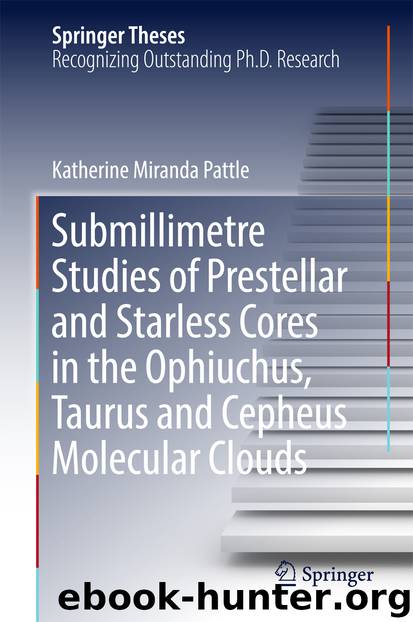Submillimetre Studies of Prestellar and Starless Cores in the Ophiuchus, Taurus and Cepheus Molecular Clouds by Katherine Miranda Pattle

Author:Katherine Miranda Pattle
Language: eng
Format: epub
Publisher: Springer International Publishing, Cham
Fig. 3.16SCUBA observations of Oph B-11, and the surrounding region. Greaves et al. (2003), “Star-Like Activity From A Very Young ‘Isolated Planet”’, Monthly Notices of the Royal Astronomical Society, vol. 346, p. 441, Figure 1. Reproduced with the permission of Oxford University Press
In order to detect this extremely faint source, we repeated the unsharp masking process used by Greaves et al. (2003) on their SCUBA map of the region. We smoothed the SCUBA-2 map with a 30 Gaussian filter, and subtracted the smoothed emission from the original map, removing all structure significantly more extended than the 14.1 beam. The data were then smoothed to a 15 beam to match the SCUBA data of Greaves et al. (2003). The unsharp-masked SCUBA-2 data are shown in Fig. 3.15. The SCUBA data used by Greaves et al. (2003) are shown in Fig. 3.16.
After removing the extended structure in this way from the SCUBA-2 map, we were able to detect Oph B-11. The emission peaks at R.A. 16:27:, Dec. :28:39. Greaves et al. (2003) found the source position to be R.A. 16:27:14.0 Dec. :28:31, while André et al. (2012) give the source position as R.A. 16:27:13.96 Dec. :28:29.3. All of these positions are consistent within the quoted errors.
We measure a peak flux density above the local background for Oph B-11 of mJy/15 beam with an uncertainty on the local background of mJy/15 beam. Greaves et al. (2003) find a peak 850-m flux density for Oph B-11 of mJy/15 beam, with an uncertainty on their local background of mJy/15 beam. Thus, our measurement of the peak flux density of Oph B-11 is consistent with that of Greaves et al. (2003). We converted our peak flux density to a mass using the Greaves et al. (2003) temperature estimate of 12–20 K, taking cmg, and assuming a distance of 139 pc. We find a mass range for Oph B-11 of 0.012–0.024 M. Thus, our data are consistent with the IRAM mass estimate (André et al. 2012), and hence with the pre-brown dwarf interpretation of Oph B-11.
The brightest source in the Greaves et al. (2003) field is the starless core B1-MM3. Greaves et al. (2003) measure a peak flux density of mJy/15 beam for B1-MM3, with a background uncertainty of mJy/15 beam. Our measured peak flux density for Oph B1-MM3 in the unsharp-masked SCUBA-2 data is mJy/15 beam, with a background uncertainty of mJy/15 beam. Thus, the flux density we measure for B1-MM3 is consistent with that measured by Greaves et al. (2003).
Download
This site does not store any files on its server. We only index and link to content provided by other sites. Please contact the content providers to delete copyright contents if any and email us, we'll remove relevant links or contents immediately.
| Aeronautics & Astronautics | Astronomy |
| Astrophysics & Space Science | Comets, Meteors & Asteroids |
| Cosmology | Mars |
| Solar System | Star-Gazing |
| Telescopes | UFOs |
Tools of Titans by Timothy Ferriss(8214)
Turbulence by E. J. Noyes(7935)
Secrets of Antigravity Propulsion: Tesla, UFOs, and Classified Aerospace Technology by Ph.D. Paul A. Laviolette(5309)
Astrophysics for People in a Hurry by Neil DeGrasse Tyson(5130)
Room 212 by Kate Stewart(5035)
Design of Trajectory Optimization Approach for Space Maneuver Vehicle Skip Entry Problems by Runqi Chai & Al Savvaris & Antonios Tsourdos & Senchun Chai(5011)
Pale Blue Dot by Carl Sagan(4907)
The David Icke Guide to the Global Conspiracy (and how to end it) by David Icke(4624)
A Journey Through Divination and Astronomy by Publishing Pottermore(4341)
Goodbye Paradise(3724)
Apollo 8 by Jeffrey Kluger(3635)
COSMOS by Carl Sagan(3553)
Losing the Nobel Prize by Brian Keating(3498)
The Five People You Meet in Heaven by Mitch Albom(3474)
How to Read Water: Clues and Patterns from Puddles to the Sea (Natural Navigation) by Tristan Gooley(3406)
Brief Answers to the Big Questions by Stephen Hawking(3369)
How to Read Nature by Tristan Gooley(3249)
The Order of Time by Carlo Rovelli(3144)
A Brief History of Time by Stephen Hawking(2959)
